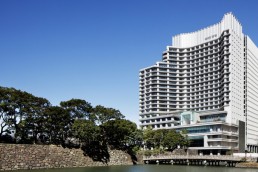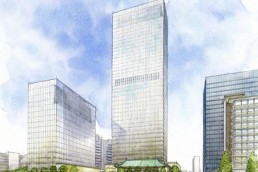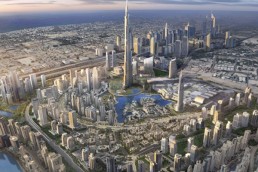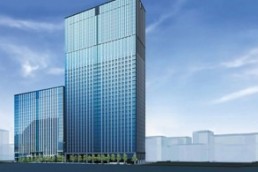Palace Hotel Tokyo opening date announced
As the anchor to a USD 1.2 billion mixed-use development, the hotel’s 10 new restaurants and bars include Japanese, Chinese and French dining venues with designs on Michelin stars.
The hotel is cutting the ribbon on the first ever evian® SPA in Japan. And its ownership, management and service standards are Japanese through and through.
“There is only one Tokyo, and there will only be one experience like the Palace Hotel,” said Takashi Kobayashi, the company’s president. “From the Aji stones at our entrance to the linens in our guest rooms, from the omotenashi at first encounter to the general management, we’re celebrating an unfiltered appreciation of our country’s culture.”
Mitsubishi’s architectural design arm designed the building while the guestroom and lobby interiors were done by London-based GA Design International, headed by Terry McGinnity.
In designing the new hotel, the development team was very sensitive to the fact that PHT will be located just across the street from Imperial Palace grounds. The utmost attention to detail was paid to every single aesthetic to ensure that the development would complement the surrounding area.
The Imperial Palace grounds – with its green space + moats – have served as the inspiration for the colours, patterns and decoratives that will be seen and experienced throughout the hotel.
One of PHT’s key distinguishing architectural features is visible at its main entrance or porte-cochere, where aji rocks quarried from Kagawa Prefecture in southern Japan line part of the wall of the main driveway. This mirrors the same aji stone that was used to construct the fortifying walls that surround the Imperial Palace and are still visible today.
Interiors have been designed to exude ‘a grand residence’ that reflects the prestige and history of the location in an elegant, yet contemporary manner.
The main lobby, being the ‘heart’ of the hotel around which all guests flow and activities branch off, will be a social hub with a relaxing sense of ‘home’. A contemporary grand fireplace will dominate the 6-metre high space and add warmth, while the double-height bookshelves bring character and add to that sense of ‘home’.
The main entrance will act as the grand entry hall of this ‘home’, while the all-day dining restaurant, Grand Kitchen – with its open kitchen concept – will exude the feel of the residence’s main kitchen / dining area (the natural gathering place for people).
Its 12 categories of accommodation range from deluxe rooms, at 45 to 55 square metres, to suites that start at 75 square metres and extend to 255 square metres. Most of the rooms feature open-style bathrooms with separate soaking tubs and showers, and more than half of the rooms and suites have open terraces and balconies.. Every guest room in the house features views of Tokyo’s Imperial Palace gardens as well as the surrounding skyline beyond.
Each room’s decor invokes the hotel’s proximity to Tokyo’s natural splendour, from the leafy carpet motifs to the earthy mix of golds and creams.
Uniquely Japanese touches to the rooms include the 300-thread count Imabari bed linens and bath towels from Ehime prefecture, and Maruyama Nori teas manufactured in Tokyo’s Tsukiji district.
Palace Hotel Tokyo is hoping for Michelin star status for several of its 10 restaurants and bars. “Our goal with each of these restaurants is not simply to complement our guests’ accommodation experience,” said Kobayashi “but to create several, new dining icons in this city – a constellation of opportunity, if you will.”
On the hotel’s sixth floor, the original Palace Hotel’s French restaurant, Crown, first opened in 1964, returns as a collaboration with Patrick Henriroux, who has maintained a two-star reputation at La Pyramide in Vienne, France for more than 10 years.
Also on the sixth floor, Michelin two-star Chef Shinji Kanesaka conducts operations at Sushi Kanesaka, one of a quartet of dining options under the Wadakura banner. Named for one of the six moats surrounding the Imperial Palace, Wadakura also offers up a tempura bar called Tatsumi and Go, an area dedicated to teppanyaki. Likewise, Go references the Imperial Palace’s ‘moat’ and Tatsumi is named for the ancient imperial watchtower visible from the restaurant’s main dining area.
On the fifth floor, Amber Palace plates up Shanghainese and Cantonese cuisines, leveraging the culinary expertise of the Chugoku Hanten Group, the same operator of Tokyo’s two-star Michelin restaurant, Fureika.
Beyond these stellar ambitions, the hotel offers all-day dining in its Grand Kitchen, featuring an eclectic selection inspired by various cuisines. At Sweets & Deli, the hotel’s cake and pastry shop, the chocolate is homemade and the breads freshly baked.
The hotel’s three bars each cultivate a different ambiance. In The Palace Lounge, a contemporary tea house commands the bright lofty space during the day, serving the finest home-grown leaves as well as selections from around the world. Sunset cues its conversion into a champagne and cocktail bar.
The sixth-floor’s chic Lounge Bar Privé seats 50 inside and half as many on a terrace outside, offering a vantage on Tokyo by day and by night. Downstairs in the Royal Bar, they’re smoking cigars and mixing martinis the old-fashioned way.
Historical insight: The counter in the Royal Bar is a restoration of the 1961 bar designed by ‘Mr. Martini’, the hotel’s very first (and ultimately long-time) bartender, and The Palace Lounge is home to an ivory-keyed Steinway, also original to the 1961-built hotel.
Occupying 1,200 square metres of space on the fifth floor, the hotel’s evian® SPA will be the first ever in Japan – and a future must for wellness in Tokyo. Its five treatment rooms, one spa suite and separate ladies’ and gentlemen’s relaxation lounge form the heart of the city’s most ambitious new spa. Its gentlemen’s spa area features a heated bath, reclining bath, cold plunge and dry sauna, and the ladies spa area includes a heated bath and marble sauna.
The spa’s design is a metaphorical reflection of the journey evian® natural mineral water takes through the Alps, from the loose stone garden at reception signifying the water’s source (mountaintop) to the ceiling of the treatment rooms reflecting ripples in a pond. Inspired by the same, the spa’s menu will encompass treatments themed around celestial restoration, mineral enrichment, precious nourishment and renewed vitality. Products by Omnisens and Anne Semonin will be incorporated throughout.
The Vitalising Signature, a treatment exclusively created for evian® SPA TOKYO, starts off with Japanese trigger point-style bodywork to improve the flow of Qi throughout before a Swedish-style deep tissue massage is applied to release tension and ‘trigger’ the body to naturally restore its own balance from within.
Beyond the spa, the hotel’s fitness facility is open around the clock, featuring exercise equipment by Technogym and Life Fitness. The hotel’s indoor pool is 20 metres long and three lanes wide, and framed on one side by wall-to-wall windows and an outdoor terrace.
The hotel also claims prime frontage on Tokyo’s renowned Marunouchi business district as well as proximity to the Nihonbashi financial centre.
Eight multi-purpose rooms comprise the hotel’s meeting facilities in addition to a formal boardroom that seats 28 and two smaller meeting rooms. The signature flourish in the main ballroom is a 7-metre tall by 22-metre wide window overlooking the Wadakura moat and the Imperial Palace gardens.
Transit from the hotel into the heart of Marunouchi – and Tokyo – is brisk business. The hotel is an approximate eight-minute walk to Tokyo Station, the city’s main terminal. Closer still, Otemachi Station – one of the city’s largest subway interchanges – is a mere two-minute stroll. Narita and Haneda International Airports are 60 and 15 kilometres away respectively.
In addition to Sweets & Deli, the uppermost, underground floor houses 17 retail outlets. Marunouchi Naka Dori – one of the area’s principal thoroughfares and tantamount to London’s Bond Street – is just a stone’s throw away while the famous Ginza shopping district is a leisurely 25-minute walk.
The new hotel succeeds two previous hotels, the Hotel Teito and Palace Hotel that occupied the same site from 1947 and 1961 respectively. Each was razed to make way for its successor.
Related Posts
14 September 2015
Hotel Okura Tokyo to be rebuilt
6 January 2010
Armani Hotel Dubai launch date announced
2 March 2009




